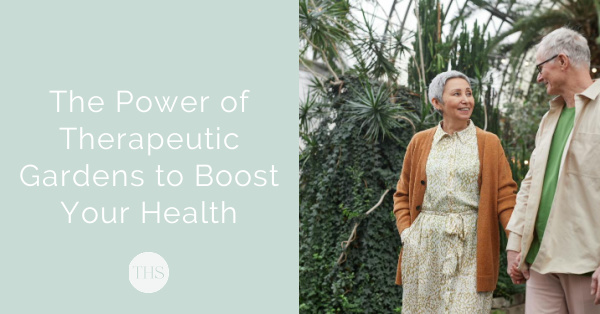7 Ways to Incorporate Eco-Friendly Products into Your Life

“Nature itself is the best physician,” said Hippocrates, an idea that was expounded in 1992 by Wilbert Gesler when he formulated the term “therapeutic landscapes.”
His research had revealed that certain environments seemed to promote “a healing sense of place,” and he sought to determine the characteristics they possessed in common. In these landscapes, three factors—the physical and built-in environment, social conditions, and human perceptions” all produced an atmosphere that was conducive to healing.
According to the American Horticultural Therapy Association, meanwhile, a therapeutic garden is “is a plant-dominated environment purposefully designed to facilitate interaction with the soothing elements of nature.”
What features do therapeutic gardens share, and how can they enhance your health if you plant such a garden in your own home?
Studies have shown that simply being in nature has a host of health effects. Healing green spaces can influence our cardiovascular functioning, and reduce stress hormone levels, heart rate, blood pressure, and muscle tension. They also boost a host of cognitive functions, with studies showing that time in nature can boost focus, ameliorate mental fatigue, and improve mood.
Therapeutic gardens can additionally have a host of social benefits. If you’ve visited a therapeutic garden before, then you know that there are places where you and others can gather, share the peace of the moment, and connect.
Finally, if you have a business or you are an employee wishing to improve your performance, know that simply being in the presence of plants boosts work productivity and improves your recovery rate when you are getting over an illness or injury. Studies have also shown that nature even helps reduce the illness rate among incarcerated persons in detention centers.
If you work in an office in a busy urban area with no green space, simply invest in a couple of indoor desk plants. As small and affordable as they are, they will make a big difference to your mood and stress levels.

If you are a businessperson and you wish to enjoy healing benefits in your workplace, then consider providing the office garden with a few must-have features. These include wide, gently graded accessible entrances and paths, raised plant beds and containers, and a sensory-oriented selection of plants that bear attractive and varying colors, textures, and fragrances.
The garden should also be adapted to the users. For instance, pathways should be wide enough to accommodate wheelchairs, and raised beds and hanging plants are an excellent way for people with mobility issues to get close and touch and smell flowers and other fragrant plants and herbs.
Additional features to include are water elements such as fountains, since studies have shown that the sound of water is a powerful stress buster. The landscape should have spaces that open up to the sky but also have shaded or covered spaces so that your employees can seek refuge on hot, sunny, or rainy days.
Art and sculpture that inspire positivity and healing can add to the mood-boosting effects of these landscapes. There should also be seating for individual users and for small groups.
Finally, any trail that exists should inspire the user to travel until the end.
The idea of therapeutic gardens has been refined over the years, to the extent that many landscapers specialize in specific garden types—including healing gardens, enabling gardens, rehabilitation gardens, and restorative gardens.
For instance, rehabilitation gardens are spaces used in therapy for people overcoming physical injuries. They often contain elements that promote strength—for instance, outdoor exercise equipment honing in on strength building, balance improvement, and flexibility training.
Restorative gardens, meant to provide relief from stress, anxiety, and depression, meanwhile, contain elements like beautifully scented flowers, fishponds, and comfortable seating areas.
Whichever garden you decide to grow or design, it is important to do your research and determine how it will be used.

You don’t need a palatial home or big yard to design a beautiful garden of your own. Currently, even those living in busy urban areas are growing their own produce, plants, and flowers thanks to the urban gardening movement. The latter invites city dwellers to grow a garden in a myriad of ways. These include the use of aeroponic towers (which are also amazing water savers), raised container beds, vertical gardens featuring a host of potted plants, and more.
If you love the idea of tucking into your own home-grown fruits and vegetables and you don’t have a yard, know that with container gardening you can grow everything from lettuce to tomatoes, zucchini, and a myriad of herbs. You simply need to purchase a container that is large enough for the produce you wish to grow, and water and care for soil as required by each fruit or vegetable.
Therapeutic landscapes have a host of benefits and can be catered to the needs of their intended users. Studies have shown that everyone—not just those in rehabilitation or in a clinic or hospital—can benefit from a little green time every day. For instance, even a few minutes a day in a healing landscape can reduce stress levels, enhance focus, and improve moods.
You don’t need a large yard or a big budget to grow a therapeutic garden. Simply ensure there is a wide array of plants, include a few fragrant plants, and think of embellishing your area with water features. The sound and sight of water can help you de-stress and reconnect with yourself at the end of a long day!
For more ideas how you can tap into the healing powers of green spaces, learn more about Nature Therapy: How to Get in 120 Minutes of Outdoor Time in with Chronic Illness and check out these tips to spend time outside in Fall and Winter despite health problems.